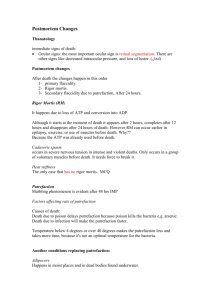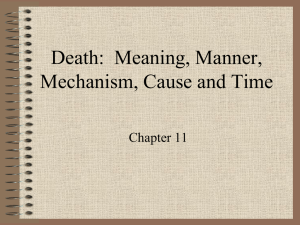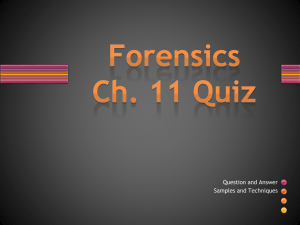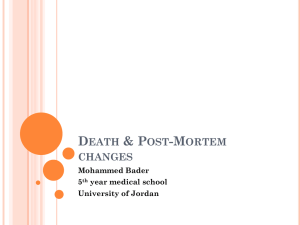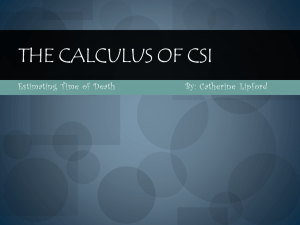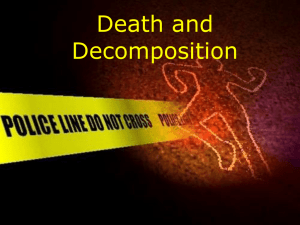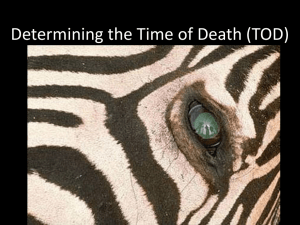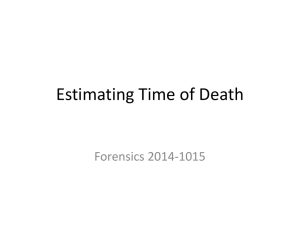Rigor Mortis - Bloodhounds Incorporated
advertisement
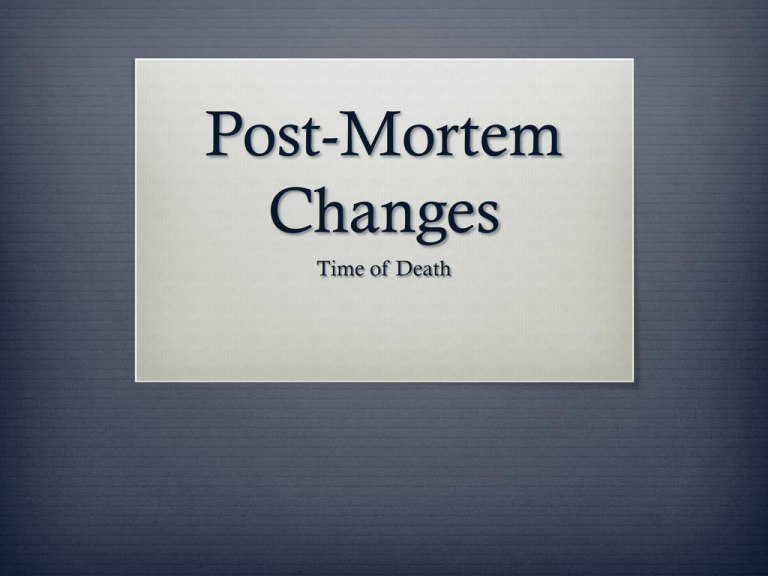
Post-Mortem Changes Time of Death Post-Mortem Changes Livor Mortis/ Hypostasis Rigor Mortis Algor Mortis/ Body Cooling Decomposition Indications of Death Indications of death: Unconsciousness Loss of all reflexes No reaction to painful stimuli Muscular flaccidity Cessation of heart beat and respiratory movement Eye signs: Loss of corneal and light reflexes Mid-dilated position of the pupils Irregular size and shape of the pupils Eyelids usually closed incompletely Tache noire: where the sclera remains exposed, two triangles of discoloration appear at each side of the cornea, either brown or black. Postmortem Ocular Changes Immediate signs in eyes Dilated or fixed pupils Absence of corneal and light reflex Marked decrease in intra-ocular pressure Late signs in eyes Cloudiness of cornea Increase in potassium levels Early Postmortem Ocular Changes Eyes remain open Thin film observed over cornea within minutes Taché noire Eyes closed upon death Cloudiness within twenty-four hours Absence of intraocular fluid suggests more than 4 days. Taché Noire Time Since Death Interval What Time Did the Person Die? Best estimate; offered with a reasonable degree of medical and scientific certainty. Impossible to be 100% accurate. UNLESS a witness (who doesn’t lie) is present at the time of death, it generally is an estimate of time (2-4 hour window is the usual). Terminology Postmortem Lividity: Physiochemical changes of the Body after Death Livor Mortis: Discoloration after Death Rigor Mortis: Stiffness after Death Algor Mortis: Body temperature after Death Putrefaction Decomposition and Autolysis Time of Death To Evaluate Time Since Death: Livor Mortis Rigor Mortis Body Temperature Stages of Decomposition Potassium Concentration in Vitreous Humor Stomach Contents Insect Activity Scene Markers Or a witness who can verify time of death What is the Forensic Significance of Hypostasis? Hypostasis is another term for Livor Mortis Helps in determining Time of death Position of the body after death Cause of death from color Hypostasis (Postmortem Lividity) Livor mortis is the settling of blood. When the heart stops, the blood stops circulating and gravity makes it settle. The areas where the blood has settled will turn pink to dark red to dark blue or purple. Starts happening immediately and is visible within a couple of hours. At this point skin is pinkish/bluish and blotchy. After five or six hours the blotches have joined up but the skin still goes white when pressed. After ten to twelve hours the blue color remains even when pressed. The lividity doesn't show where the body is in contact with something. Thus a body lying on its back will show lividity in the small of its back, its neck etc., but not parts of the body directly touching the ground. This a very useful when determining if a body has been moved after death. Hypostasis/Livor Mortis Livor Mortis Postmortem Lividity Early stages can “Blanch” the skin Can shift position(s) from 1-8 hours 8-12 hours congeals in capillary beds After 12 -24 hours the lividity is typically “fixed” Can continue to move up to 3 days after death Blanching Thumb pressure indicates that the lividity is not fully fixed. Blanching Distribution of Hypostasis If the body remains vertical after death as in hanging cases, hypostasis will be most marked in the feet and to a lesser extent the hands. Livor Mortis Noticeable approximately 30 minutes to 2 hours after death. Reddish purple coloration in dependent areas of the body. Due to accumulation of blood secondary to gravity. Dependent areas resting on a hard surface may appear pale in color. Livor Mortis Sites of Hypostasis Depends on the position of the body before death: Supine: shoulders, buttocks heels pressing against surface gives white color (pale). Vertical (hanging): distally in legs & feet. Drowning: chest, upper chest, and upper limbs. Face-down death: as in epilepsy, drunken victims whitening around nose & lips. Hypostasis may also occur in viscera: Heart: mistaken for MI Lungs: mistaken for pneumonia Intestine: mistaken for hemorrhagic infarction Lividity Postmortem Changes Postmortem changes are affected by: Victim’s Age Victim’s Pre-morbid Health Level of Activity at time of death Type of drugs taken prior to death Ingestion of drugs prior to death Current Environmental conditions Can you see hypostasis in the internal organs? Yes The lung is dark purple in the posterior dependent areas as a result of livor mortis. This may simulate congestion. Lividity Cause of Death Analyzed by Livor Mortis Etiology Color of Liver Mechanism Normal Red-Blue-Purple Venous Blood Carbon Monoxide Pink, cherry-red Carboxyhemoglobin Cyanide Pink, cherry-red Excessive oxygenated blood because of inhibition of cytochrome oxidase Refrigeration/hypothermia Pink, cherry-red Oxygen retention in cutaneous blood by cold air Hydrogen sulfate Green Sulfhemoglobin Sodium chlorate Brown Methemoglobin Hypostasis vs. Bruises (Ecchymosis) Hypostasis Dependant areas Bruises Any where Well defined edges Blood is retained in intact capillaries Superficial Same level on surface Pale over pressure areas Incision: blood flows from the cut vessel (washable) No swelling Ill defined edges Blood escapes through ruptured capillaries Deep into skin Raised Red Incision: blood coagulates in tissue May be with swelling With a bruise, blood will not flow from the cut Hypostasis In advanced stages, skin level capillaries can hemorrhage This causes pinpoint breaks in the skin called “Tardieu Spots” or petechiae. Can see petechiae on internal organs. These are minute hemorrhages in the soft tissue. Scars show no lividity Purpura = patches of purplish discoloration due to rupture of small vessels. Tardieu Spots Tardieu spots are petechiae and purpuric hemorrhages that develop in areas of dependency secondary to the rupture of degenerating vessels under the influence of increased pressure from gravity Tardieu Spots Tardieu Spots Postmortem Rigor Mortis Rigor Mortis Chemical changes causes muscle mass to become rigid; looks like body is frozen in place (fixed) Small muscles go into rigor first Rigor usually occurs from head to toe Rigor = Rigid Mortis = Death Rigor Mortis Formation Mechanisms Leading to Rigor: Metabolic activity after death continues for short time and becomes anaerobic (lacking oxygen) ATP hydrolyzes to ADP Calcium ions diffuse from sarcoplasmic reticulum Causes chemical lock between actin and myosin proteins, THEN As body proteins decompose, chemical locks breakdown and muscles become flaccid again. Time table for Rigor Mortis Rigor can be seen within 30 min. to 1 hour after death. Covers the entire body after 8-12 hours. Complete Rigor will remain for about 8-12 hrs. Rigor begins to dissipate over the next 12 hrs. This is dependent on environmental temperatures Fully flaccid body by 36 hours. Cadaveric Spasm Drowning Great Excitement prior to death Rigor Mortis Rigor is accelerated by Prior exercise Convulsions Electrocution Hyperpyrexia Hot environmental temperatures Age (does not form well in children) Strychnine poisoning Rigor is inhibited by Hypothermia Cold environment Factors affecting timing of RM Environmental temperature: Cold and wet onset slow, duration longer Hot and dry onset fast, duration shorter Muscular activity before death: Muscles healthy and robust, at rest before death slow onset, duration longer Muscles exhausted/ fatigued onset rapid, esp in those limbs being used (eg in someone running at time of death, lower limbs develop RM faster than upper limbs) Increase activity (convulsions, electrocution, lightning) rapid onset & short duration Factors affecting timing of RM Age: Extremes of age rapid onset Health: Cause of death: Asphyxia, pneumonia, nervous de’s with muscle paralysis & dehydration slow onset Septicemia & poisoning rapid onset, may even be absent, especially in limbs affected by septicemia Emaciated or died of wasting disease rapid onset, short duration RM: time estimation Warm Flaccid Death < 3 hrs Warm Stiff 3-8 hrs Cold Stiff 8-36 hrs Cold Flaccid Death > 36 hrs What is the Forensic Significance of Rigor Mortis? Can tell Time of Death Can tell whether the body has been moved May be able to tell cause of death Cadaveric Spasm Known as instantaneous rigor, cataleptic rigidity, or instantaneous rigidity Rare form of muscular stiffening that occurs at the moment of death, persists into the period of rigor mortis and can be mistaken for rigor mortis The cause is unknown, but usually associated with violent deaths happening with intense emotion Occurs in deaths Of Drowning That occur with great excitement of tension Cadaveric Spasm Rigor Mortis vs. Cadaveric Spasm Rigor mortis Cadaveric spasm Onset delayed after death (2-3 hrs) Duration approx 12-24 hrs Onset is instantaneous Duration is a few hours, until it is replaced by rigor mortis Intensity comparatively moderate Intensity comparatively very strong Mechanism of formation: breakdown of Mechanism of formation unknown, but ATP below critical level predisposing factors: Excitement, fear, fatigue, exhaustion, nervous tension, contraction of muscles at time of death All muscles of the body are affected Selected muscles, which were in a state gradually. of contraction at the time of death, are affected. Cadaveric spasm in a drowning victim: had grass from the river bank firmly clutched in the hand What is the Forensic Significance of Cadaveric Spasm? Diagnosis of suicide as in case of weapon found in hand Drowning Diagnosis ID of assailant as in case of evidence in hand May allow one to know state of person prior to death Stress Exercise Algor Mortis Algor Mortis (Body Cooling) Body cools from normal internal temperature to the temperature in the environment. Liver or brain temperatures are taken for core temperature Body cooling is inaccurate in obtaining time of death. In 70 – 75°F, the body cools 2.5°F to 2.0°F for first hour, then 1.5 to 2.0°F for next twelve hours, then 1.0°F for next 12 hours. Time since death = 98.6°F – Rectal Temp (°F)/ 1.5 The rectum should be checked before insertion of the thermometer (May have been a sexual assault) Patient may not die immediately after assault. This may change time of death by several hours. Algor Mortis Under average conditions the body cools 2.0°F to 2.5°F per hour during the first hours and slower thereafter with an average loss of 1.5°F to 2°F during the first 12 hours and 1F for the next twelve to eighteen hours. Measure inner core temperature Liver or brain Factors affecting Rate of Cooling Body weight: Larger bw: slower cooling Smaller bw: faster cooling Edema: slower cooling rate. Surface area of the body: Larger surface area speeds up cooling rate. Children: increase surface area gives rapid heat loss. Factors affecting Rate of Cooling Clothing, posture and emaciation Environmental Temperature: Higher humidity: rapid cooling rate Rapid air velocity: rapid cooling rate Water: Rapid cooling rate: More rapid in flowing water than still water If there is a fulminating infection, e.g. septicemia, the body temperature may continue to rise for some hours after death. POST-MORTEM DECOMPOSITION Post-Mortem Decomposition 1. Putrefaction 2. Mummification 3. Adipocere 4. Skeletonization Decomposition The decomposition of a body can be divided into several stages, even if the duration of each stage will vary a lot: 2 - 3 days: green staining begins on the right side of the abdomen. 3 - 4 days: staining spreads. Body begins to swell. Veins go "marbled" - a browny black discoloration 5-6 days: abdomen swells with gas. Skin blisters 2 weeks: abdomen very tight and swollen. 3 weeks: tissue softens. Organs and cavities bursting. Nails fall off 4 weeks: soft tissues begin to liquefy. Face becoming unrecognizable 4 - 6 months: formation of adipocere, if in damp place. This is when the fat goes all hard and waxy. A body without a coffin will be decayed within 12 years. Marbling (Arborization) Marbling Marbling with Purging Putrefaction The normal final sign of death. Starts immediately after death at the cellular level Becomes visible in 48-72 hrs. Its onset may be sped up or delayed by several factors mainly: Temperature Humidity Two phenomena for putrefaction: Autolysis: occurs by digestive enzymes released from the cells after death. Bacterial action: most of them come from the bowel and Clostridium welchii predominates (same bacteria that causes gas gangrene) The 1st visible sign of putrefaction is green or greenish red discoloration of the skin of the anterior abdominal wall Normally starts in the right iliac fossa. The Next phase: Gas formation Blisters containing red fluid appear on the skin, mistaken as bleeding Humidity, temperature, bacterial activity body proteins break into polypeptides & amino acids Brain & Epithelial tissues are the 1st to be affected by putrefaction Heart, Uterus & Prostate may survive for longer periods. Military Plaques: nodules in heart (epi/endocardial) Marbling: bacteria colonize venous system hemolysis stain. Putrefaction Three Stages of Body Breakdown Early Stage: 24-36 hours Green-like discoloration, usually in abdomen (R- low) due to denaturation of bacteria in the colon Early decompositional changes are manifested by green discoloration over the abdomen. Putrefaction Middle Stage: 36-48 hours Gaseous bloating, green-purple color in face, neck and shoulders. Putrefaction Putrefaction Putrefaction Late Stage: greater than 72 hours Bloating Postmortem mucosal purge, tongue swells and protrudes, venous marbling of subcutaneous vessels Skin blebs or blistering Explosion of this person can occur Putrefaction Putrefaction Late Stage (Cont.): greater than 72 hours Skin and hair slippage skin of hands or feet can shed with nails intact Marked bloating (1-3X) Skeletonization (from 4-5 days and up to 1.5 years depending on the climate). Putrefaction Putrefaction Putrefaction Skin Slippage Fingerprinting Using Finger From Deceased Putrefaction Influences on Putrefaction A high environmental humidity will enhance putrefaction. The rate of putrefaction is influenced by the bodily habits of the decedent; obese individuals putrefy more rapidly than those who are lean. Putrefaction will be delayed in deaths from exsanguination (bleeding to death) because blood provides a channel for the spread of putrefactive organisms within the body. Conversely, putrefaction is more rapid in persons dying with widespread infection, congestive cardiac failure or retention of sodium and salts. It tends to be more rapid in children than in adults, but the onset is relatively slow in unfed new-born infants because of the lack of commensal bacteria. Influences on Putrefaction Heavy clothing and other coverings, by retaining body heat, will speed up putrefaction. Rapid putrefactive changes may been seen in corpses left in a room which is well heated, or in a bed with an electric blanket. Injuries to the body surface promote putrefaction by providing portals of entry for bacteria and the associated blood provides an excellent medium for bacterial growth. Case Study A 74-year old white male adult was found dead in his one room apartment. When police arrived they found him face down sprawled across his bed. The room was approximately 75°F. There were no apparent injuries to this individual. Police concluded the death was natural and did not called the Coroner’s office. Do you agree with their conclusion? Why or why not? Write down your answer and give a full explanation why you think the police were either correct or wrong. Make sure to use terminology presented in this power point presentation.
